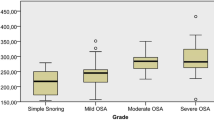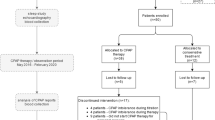Abstract
Objective
Adropin is a recently discovered peptide hormone that plays a vital role in metabolism and cardiovascular-cerebrovascular function. The purpose of this study is to investigate the role of circulating adropin levels in patients with obstructive sleep apnea-hypopnea syndrome (OSAHS) and further determine the relationship between serum adropin concentration and endothelial dysfunction in patients with OSAHS.
Methods
Forty polysomnography-diagnosed patients with OSAHS and 21 age and sex-matched healthy controls were enrolled in the current study. Serum adropin level, endothelial function parameters including flow-mediated dilatation (FMD) of brachial artery, endothelin-1 (ET-1), and nitric oxide (NO) were measured in all participants.
Results
Serum adropin levels were significantly lower in patients with OSAHS compared to the control subjects. FMD was lower and serum ET-1 levels were higher in patients with OSAHS compared to control subjects. No significant difference was seen in serum NO levels between the two groups. Multivariate linear regression analysis revealed that serum adropin level was positively associated with FMD and negatively correlated with AHI. Additionally, serum adropin levels were lower in patients with OSAHS who had endothelial dysfunction compared with those patients without endothelial dysfunction. The receiver operating characteristic (ROC) analysis showed that area under the curve (AUC) for serum adropin in predicting endothelial dysfunction status in patients with OSAHS was 0.815 (95% CI 0.680–0.951, p = 0.001). The cutoff value of serum adropin level was less than 235.0 pg/mL, which provided the sensitivity and specificity of 81% and 75%, respectively, for the detection of endothelial dysfunction in patients with OSAHS.
Conclusion
Lower circulating adropin levels are closely associated with endothelial dysfunction in patients with OSAHS. Circulating adropin level may serve as an early biomarker to predict the development of endothelial dysfunction before the emergence of clinical symptoms in patients with OSAHS.

Similar content being viewed by others
References
Caples SM, Gami AS, Somers VK (2005) Obstructive sleep apnea. Ann Intern Med 142(3):187–197
Punjabi NM (2008) The epidemiology of adult obstructive sleep apnea. Proc Am Thorac Soc 5(2):136–143
Kokturk O, Ciftci TU, Mollarecep E, Ciftci B (2005) Elevated C-reactive protein levels and increased cardiovascular risk in patients with obstructive sleep apnea syndrome. Int Heart J 46(5):801–809
Gozal D, Kheirandish-Gozal L, Serpero LD, Sans Capdevila O, Dayyat E (2007) Obstructive sleep apnea and endothelial function in school-aged nonobese children: effect of adenotonsillectomy. Circulation. 116(20):2307–2314
Somers VK, White DP, Amin R, Abraham WT, Costa F, Culebras A, Daniels S, Floras JS, Hunt CE, Olson LJ, Pickering TG, Russell R, Woo M, Young T (2008) Sleep apnea and cardiovascular disease: an American Heart Association/American College Of Cardiology Foundation scientific statement from the American Heart Association Council for high blood pressure research professional education committee, council on clinical cardiology, stroke council, and council on cardiovascular nursing. In collaboration with the National Heart, Lung, And Blood Institute National Center On Sleep Disorders Research (National Institutes Of Health). Circulation 118(10):1080–1111
Kato M, Roberts-Thomson P, Phillips BG, Haynes WG, Winnicki M, Accurso V, Somers VK (2000) Impairment of endothelium-dependent vasodilation of resistance vessels in patients with obstructive sleep apnea. Circulation. 102(21):2607–2610
Castellon X, Bogdanova V (2016) Chronic inflammatory diseases and endothelial dysfunction. Aging Dis 7(1):81–89
Kumar KG, Trevaskis JL, Lam DD, Sutton GM, Koza RA, Chouljenko VN, Kousoulas KG, Rogers PM, Kesterson RA, Thearle M, Ferrante AW Jr, Mynatt RL, Burris TP, Dong JZ, Halem HA, Culler MD, Heisler LK, Stephens JM, Butler AA (2008) Identification of adropin as a secreted factor linking dietary macronutrient intake with energy homeostasis and lipid metabolism. Cell Metab 8(6):468–481
Aydin S, Kuloglu T, Aydin S, Eren MN, Yilmaz M, Kalayci M, Sahin I, Kocaman N, Citil C, Kendir Y (2013) Expression of adropin in rat brain, cerebellum, kidneys, heart, liver, and pancreas in streptozotocin-induced diabetes. Mol Cell Biochem 380(1–2):73–81
Lovren F, Pan Y, Quan A, Singh KK, Shukla PC, Gupta M, Al-Omran M, Teoh H, Verma S (2010) Adropin is a novel regulator of endothelial function. Circulation. 122(11 Suppl):S185–S192
Lian W, Gu X, Qin Y, Zheng X (2011) Elevated plasma levels of adropin in heart failure patients. Intern Med 50(15):1523–1527
Ganesh Kumar K, Zhang J, Gao S, Rossi J, McGuinness OP, Halem HH, Culler MD, Mynatt RL, Butler AA (2012) Adropin deficiency is associated with increased adiposity and insulin resistance. Obesity (Silver Spring) 20(7):1394–1402
Aydin S, Kuloglu T, Aydin S, Kalayci M, Yilmaz M, Çakmak T, Eren MN (2014) Elevated adropin: a candidate diagnostic marker for myocardial infarction in conjunction with troponin-I. Peptides. 58:91–97
Topuz M, Celik A, Aslantas T, Demir AK, Aydin S, Aydin S (2013) Plasma adropin levels predict endothelial dysfunction like flow-mediated dilatation in patients with type 2 diabetes mellitus. J Investig Med 61(8):1161–1164
Oruc CU, Akpinar YE, Dervisoglu E, Amikishiyev S, Salmaslıoglu A, Gurdol F, Omer B (2017) Low concentrations of adropin are associated with endothelial dysfunction as assessed by flow-mediated dilatation in patients with metabolic syndrome. Clin Chem Lab Med 55(1):139–144
Gozal D, Kheirandish-Gozal L, Bhattacharjee R, Molero-Ramirez H, Tan HL, Bandla HP (2013) Circulating adropin concentrations in pediatric obstructive sleep apnea: potential relevance to endothelial function. J Pediatr 163(4):1122–1126
Bozic J, Borovac JA, Galic T, Kurir TT, Supe-Domic D, Dogas Z. Adropin and inflammation biomarker levels in male patients with obstructive sleep apnea: a link with glucose metabolism and sleep parameters. J Clin Sleep Med. 2018;14(7):\–1118. Published 2018 Jul 15. doi:https://doi.org/10.5664/jcsm.7204
Medical Advisory Secretariat (2006) Polysomnography in patients with obstructive sleep apnea: an evidence-based analysis. Ont Health Technol Assess Ser 6(13):1–38
Epstein L, Kristo D, Strollo PJ Jr, Friedman N, Malhotra A, Patil SP, Ramar K, Rogers R, Schwab RJ, Weaver EM, Weinstein MD (2009) Adult obstructive sleep apnea task force of the American Academy of Sleep Medicine. Clinical guideline for the evaluation, management and long-term care of obstructive sleep apnea in adults. J Clin Sleep Med 5(3):263–276
Johns MW (1991) A new method for measuring daytime sleepiness: the Epworth sleepiness scale. Sleep. 14(6):540–545
Coretti MC, Anderson TJ, Benjamin EJ, Celermajer D, Charbonneau F, Creager MA, Deanfield J, Drexler H, Gerhard-Herman M, Herrington D, Vallance P, Vita J, Vogel R (2002) International Brachial Artery Reactivity Task Force. Guidelines for the ultrasound assessment of endothelial-dependent flow-mediated vasodilation of the brachial artery: a report of the international brachial artery reactivity task force. J Am Coll Cardiol 39(2):257–265
Thijssen DH, Black MA, Pyke KE, Padilla J, Atkinson G, Harris RA, Parker B, Widlansky ME, Tschakovsky ME, Green DJ (2011) Assessment of flow-mediated dilation in humans: a methodological and physiological guideline. Am J Physiol Heart Circ Physiol 300(1):H2–H12. https://doi.org/10.1152/ajpheart.00471.2010
Doshi SN, Naka KK, Payne N et al (2001) Flow-mediated dilatation following wrist and upper arm occlusion in humans: the contribution of nitric oxide. Clin Sci (Lond) 101(6):629–635
Celermajer DS, Sorensen KE, Gooch VM, Spiegelhalter DJ, Miller OI, Sullivan ID, Lloyd JK, Deanfield JE (1992) Non-invasive detection of endothelial dysfunction in children and adults at risk of atherosclerosis. Lancet 340(8828):1111–1115
Alley H, Owens CD, Gasper WJ, Grenon SM (2014) Ultrasound assessment of endothelial-dependent flow-mediated vasodilation of the brachial artery in clinical research. J Vis Exp 92:e52070
Goetze JP, Albrethsen J (2014) Adropin: a new regulatory peptide in cardiovascular endocrinology. Regul Pept 190–191:41–42
Lamers D, Schlich R, Greulich S et al (2011) Oleic acid and adipokines synergize in inducing proliferation and inflammatory signalling in human vascular smooth muscle cells[J]. J Cell Mol Med 15(5):1177–1188
Lefer DJ, Jones SP, Girod WG et al (1999) Leukocyte-endothelial cell interactions in nitric oxide synthase-deficient mice. Am J Phys 276(6 Pt 2):H1943–H1950
Cockrell A, Laroux FS, Jourd’heuil D, Kawachi S, Gray L et al (1999) Role of inducible nitric oxide synthase in leukocyte extravasation in vivo. Biochem Biophys Res Commun 257(3):684–686
Sedgwick JD, Riminton DS, Cryster JG, Körner H (2000) Tumor necrosis factor: a master-regulator of leukocyte movement. Immunol Today 21(3):110–113
Cirino G, Fiorucci S, Sessa WC (2003) Endothelial nitric oxide synthase: the Cinderella of inflammation? Trends Pharmacol Sci 24(2):91–95
Gu X, Li H, Zhu X, Gu H, Chen J, Wang L, Harding P, Xu W (2015) Inverse correlation between plasma adropin and ET-1 levels in essential hypertension: a cross-sectional study. Medicine (Baltimore) 94(40):e1712
Pernow J, Shemyakin A, Böhm F (2012) New perspectives on endothelin-1 in atherosclerosis and diabetes mellitus. Life Sci 91(13–14):507–516
Ahirwar AK, Jain A, Singh A, Goswami B, Bhatnagar MK, Bhatacharjee J (2015) The study of markers of endothelial dysfunction in metabolic syndrome. Horm Mol Biol Clin Invest 24(3):131–136
Butler AA, Tam CS, Stanhope KL, Wolfe BM, Ali MR, O'Keeffe M, St-Onge MP, Ravussin E, Havel PJ (2012) Low circulating adropin concentrations with obesity and aging correlate with risk factors for metabolic disease and increase after gastric bypass surgery in humans. J Clin Endocrinol Metab 97(10):3783–3791
Altincik A, Sayin O (2015) Evaluation of the relationship between serum adropin levels and blood pressure in obese children. J Pediatr Endocrinol Metab 28(9–10):1095–1100
Funding
This work was supported by the National Key R&D Program of China (2018YFC1311900) and National Natural Science Foundation of China (No. 81873406).
Author information
Authors and Affiliations
Corresponding author
Ethics declarations
Conflict of interest
The authors declare that they have no conflict of interest.
Ethical approval
All procedures performed in studies involving human participants were in accordance with the ethical standards of the Committee of Human Research in Xiangya Hospital, Central South University.
Informed consent
Informed consent was obtained from all individual participants included in the study.
Additional information
Publisher’s note
Springer Nature remains neutral with regard to jurisdictional claims in published maps and institutional affiliations.
Ziwen Fan and Yan Zhang are co-first authors.
Electronic supplementary material
ESM 1
(DOCX 16 kb)
Rights and permissions
About this article
Cite this article
Fan, Z., Zhang, Y., Zou, F. et al. Serum adropin level is associated with endothelial dysfunction in patients with obstructive sleep apnea and hypopnea syndrome. Sleep Breath 25, 117–123 (2021). https://doi.org/10.1007/s11325-020-02072-7
Received:
Revised:
Accepted:
Published:
Issue Date:
DOI: https://doi.org/10.1007/s11325-020-02072-7




